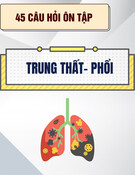
HUE JOURNAL OF MEDICINE AND PHARMACY ISSN 3030-4318; eISSN: 3030-4326HUE JOURNAL OF MEDICINE AND PHARMACY ISSN 3030-4318; eISSN: 3030-4326
194 195
Hue Journal of Medicine and Pharmacy, Volume 15, No.2/2025 Hue Journal of Medicine and Pharmacy, Volume 15, No.2/2025
*Corresponding author: Hoang Anh Tien. Email: hatien@huemed-univ.edu.vn
Received: 18/2/2025; Accepted: 15/4/2025; Published: 28/4/2025
DOI: 10.34071/jmp.2025.2.27
Cardiovascular risk factors and target organ damage in hypertensive
patients at Hue University of Medicine and Pharmacy Hospital
Duong Minh Quy, Hoang Anh Tien*, Doan Khanh Hung
Cardiology Center, Hue University of Medicine and Pharmacy Hospital
Abstract
Background: Hypertension is one of the most common cardiovascular diseases, often referred to as the
silent killer. The prevalence of hypertension is increasing globally. This study investigates certain clinical and
subclinical characteristics, cardiovascular risk factors in hypertensive patients, and evaluates the correlation
between these risk factors and target organ damage with systolic and diastolic blood pressure. Subjects and
methods: This was a cross-sectional descriptive study of hypertensive patients treated at Hue University of
Medicine and Pharmacy Hospital from January 1, 2024, to December 31, 2024. Results: The study included
215 hypertensive patients, with a blood pressure control rate of 35.8%. Patients whose blood pressure was
controlled had a younger age, lower BMI, a lower incidence of smoking, lower LDL-C levels, and lower rates
of cerebrovascular accidents and diabetes, all showing statistical significance compared to the uncontrolled
group. The high cardiovascular risk group had higher blood glucose and lower HDL-C levels, both statistically
significant compared to the low cardiovascular risk group. A moderate positive correlation was found
between systolic blood pressure and smoking, a strong positive correlation between systolic blood pressure
and blood glucose, and a moderate positive correlation between systolic blood pressure and the Gensini
score. Conclusion: There is a correlation between cardiovascular risk factors and blood pressure control.
Achieving target blood pressure helps reduce the risk of target organ damage.
Keywords: Hypertension, target organ damage, cardiovascular risk factors.
1. INTRODUCTION
Hypertension (HTN) remains a significant societal
issue today. The prevalence of HTN in Vietnam is
increasing, with a national epidemiological survey
(2001 - 2008) conducted on 9,832 individuals aged
≥25 years showing that 25.1% of the population
had HTN, nearly half of whom were unaware of
their condition. More recently, results from the May
Measure Month (MMM) 2022 program indicated
that 36.2% of surveyed individuals had hypertension,
and 44% of patients on antihypertensive medication
had uncontrolled blood pressure [1].
Additionally, the prevalence of major
cardiovascular risk factors in Vietnam is still high.
Among those aged 25 - 64 in 2015, the rate of
dyslipidemia was 30.2%, and the rate of diabetes
was 4.1%. Moreover, among the population aged
25 - 64 in Vietnam, the rate of overweight/obesity
was 12.0% in 2010 and rose sharply to 17.5% in
2015. Vietnamese people tend to consume high
amounts of salt and sugar, and the rates of smoking
and alcohol consumption in men are also high 2.
In 2005, 46% of patients with acute myocardial
infarction treated at the Vietnam National Heart
Institute were directly related to hypertension, and
more than one-third of stroke cases treated at the
Vietnam Neurology Institute in 2003 were related to
hypertension [3, 4].
Therefore, evaluating and providing information
to hypertensive patients regarding their
cardiovascular risk is very important. However, in
Hue City, there have been relatively few studies
on hypertension, cardiovascular risk factors, and
target organ damage. For this reason, we conducted
the study: “Cardiovascular Risk Factors and Target
Organ Damage in Hypertensive Patients at Hue
University Hospital” aiming at two objectives:
1. To investigate certain clinical, subclinical
characteristics and cardiovascular risk factors in
hypertensive patients.
Abbreviations:
• HTN: Hypertension
• MMM (May Measure Month): Blood Pressure
Measurement Month Program
• SBP: Systolic Blood Pressure
• DBP: Diastolic Blood Pressure
• BMI: Body Mass Index
• HDL-C: High Density Lipoprotein Cholesterol
• LDL-C: Low Density Lipoprotein Cholesterol
• EF: Ejection Fraction






























